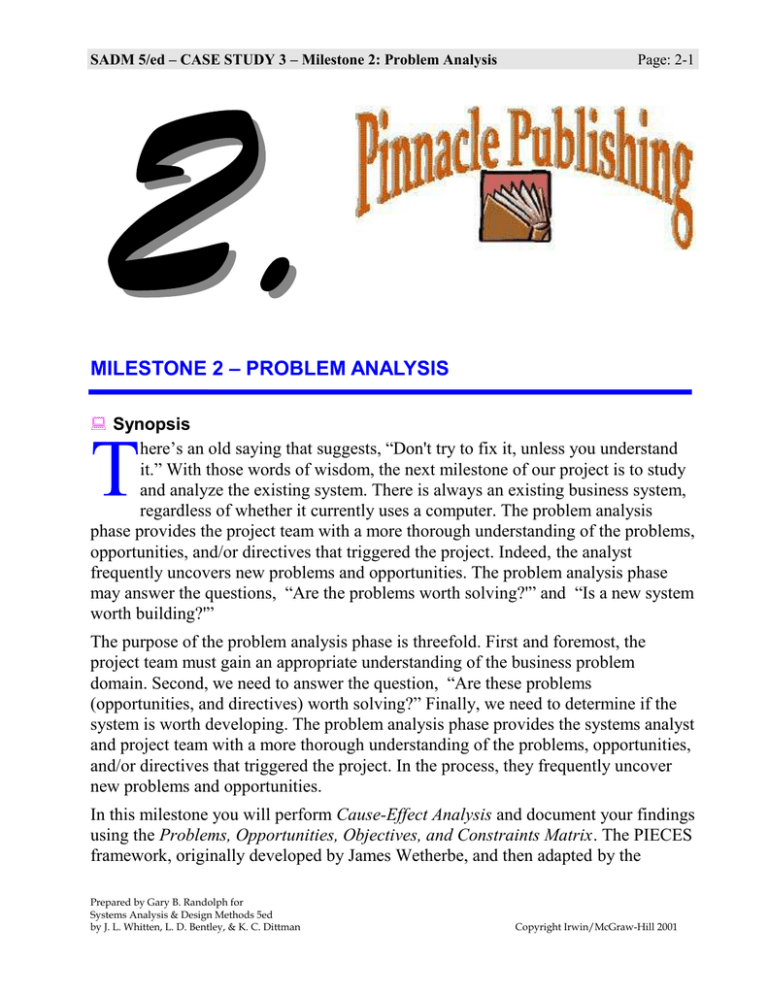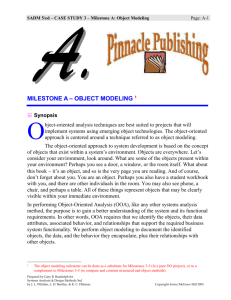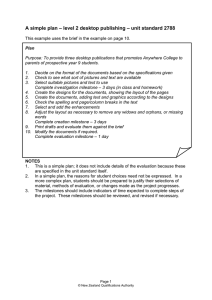T – PROBLEM ANALYSIS MILESTONE 2
advertisement

SADM 5/ed – CASE STUDY 3 – Milestone 2: Problem Analysis Page: 2-1 MILESTONE 2 – PROBLEM ANALYSIS Synopsis here’s an old saying that suggests, “Don't try to fix it, unless you understand it.” With those words of wisdom, the next milestone of our project is to study and analyze the existing system. There is always an existing business system, regardless of whether it currently uses a computer. The problem analysis phase provides the project team with a more thorough understanding of the problems, opportunities, and/or directives that triggered the project. Indeed, the analyst frequently uncovers new problems and opportunities. The problem analysis phase may answer the questions, “Are the problems worth solving?'” and “Is a new system worth building?'” T The purpose of the problem analysis phase is threefold. First and foremost, the project team must gain an appropriate understanding of the business problem domain. Second, we need to answer the question, “Are these problems (opportunities, and directives) worth solving?” Finally, we need to determine if the system is worth developing. The problem analysis phase provides the systems analyst and project team with a more thorough understanding of the problems, opportunities, and/or directives that triggered the project. In the process, they frequently uncover new problems and opportunities. In this milestone you will perform Cause-Effect Analysis and document your findings using the Problems, Opportunities, Objectives, and Constraints Matrix. The PIECES framework, originally developed by James Wetherbe, and then adapted by the Prepared by Gary B. Randolph for Systems Analysis & Design Methods 5ed by J. L. Whitten, L. D. Bentley, & K. C. Dittman Copyright Irwin/McGraw-Hill 2001 SADM 5/ed – CASE STUDY 3 – Milestone 2: Problem Analysis Page: 2-2 authors, can serve as a useful tool to classify the various problems, opportunities, and directives identified in Milestone 1. Objectives After completing this milestone, you should be able to: Perform Cause-Effect Analysis to be able to thoroughly understand a system’s problems, opportunities, and/or directives that triggered the project. Use and understand the PIECES framework for classifying problems, opportunities, and directives. Complete the Problems, Opportunities, Objectives, and Constraints Matrix. Prerequisites Before starting this milestone the following topics should be covered: 1. 2. 3. 4. The problem analysis phase – Chapters 3 and 5 Problem analysis techniques – Chapter 6 PIECES Framework – Chapters 3 and 5 Milestone 1 Solution Assignment Now that we have completed the survey of the system, and gained approval to proceed, we can now attempt to gain a better understanding of the current system. In this assignment, we will use our results of Milestone 1, plus the case background information and the user interview, to perform cause-effect analysis. The results of this activity will provide us a better understanding of the problems, opportunities, and constraints of the current system. Activities 1. To complete the Problems, Opportunities, Objectives, and Constraints Matrix, use the interview presented in this milestone. Use the PIECES framework as a model to classify the problems, opportunities, and directives. Deliverable format and software to be used are according to your instructor’s specifications. Deliverables should be neatly packaged in a binder, separated with a tab divider labeled “Milestone 2,” and optionally accompanied with a Milestone Evaluation Sheet. Prepared by Gary B. Randolph for Systems Analysis & Design Methods 5ed by J. L. Whitten, L. D. Bentley, & K. C. Dittman Copyright Irwin/McGraw-Hill 2001 SADM 5/ed – CASE STUDY 3 – Milestone 2: Problem Analysis Page: 2-3 References: Case Background Case Study Introduction Milestone 1 Solution Provided by your instructor Transcripts of Pinnacle meeting Exhibit 2.1 Templates See online learning center web site for the textbook. Prepared by Gary B. Randolph for Systems Analysis & Design Methods 5ed by J. L. Whitten, L. D. Bentley, & K. C. Dittman Copyright Irwin/McGraw-Hill 2001 SADM 5/ed – CASE STUDY 3 – Milestone 2: Problem Analysis Page: 2-4 Deliverables: Problems, Opportunities, Objectives, and Constraints Matrix: Due: __/__/__ Time:_______ ADVANCED OPTIONS Write a detailed study report for the phase. This deliverable was not discussed in the narrative, because students need to be exposed to modeling (data, process, & interface) before this report can be completed. For those ambitious individuals who are familiar with those skills and wish to be challenged, use the detailed study report outline found in Chapter 5 of the textbook as a guideline. Another advanced option is to develop one or more fishbone diagrams for problems outlined in the case. To complete this advanced option, you may need to make some assumptions about causes and effects. Study Report: Due: __/__/__ Time:_______ Fishbone Diagrams Due: __/__/__ Time:_______ Milestone’s Point Value: Prepared by Gary B. Randolph for Systems Analysis & Design Methods 5ed by J. L. Whitten, L. D. Bentley, & K. C. Dittman ____ Copyright Irwin/McGraw-Hill 2001 SADM 5/ed – CASE STUDY 3 – Milestone 2: Problem Analysis Page: 2-5 Exhibit 2.1 The following is a copy of the transcript of a meeting of Cindy Natale, Brett Ramiriz, Mary O’Neal, and John Bridgham, the latter three of Pinnacle Publishing. Cindy requested this meeting after presenting Brett with her initial Problem Statement Matrix. Scene: The boardroom of Pinnacle Publishing. Cindy: Good Afternoon. Brett, it is nice to see you again. Mr. Bridgham, we met briefly the other day. And you must be Ms. O’Neal. Mary: Call me Mary. John: And call me John. By the way, I don’t want to rain on your parade, Cindy, but can you give me some idea of how long this is going to take? I’m pretty busy. Cindy: I appreciate the fact that you are all very busy. Thank you for granting me this time. I promise to keep this as brief as possible. But I know how important this information system will be to your company, and I’m sure you want to get it right. I think we can finish within the hour. We can probably do this in thirty minutes if we stay on task. Brett: Then let’s get on task. Cindy: Okay. Brett, you’ve already seen the Problem Statement Matrix I prepared from our meeting the other day. Here are copies I’ve made for everyone. Prepared by Gary B. Randolph for Systems Analysis & Design Methods 5ed by J. L. Whitten, L. D. Bentley, & K. C. Dittman John: Thank you. Cindy: What I’d like to do today is flesh that out a little, looking at the causes of those problems and how you all expect the new system to solve those problems. Are there any questions on what I have here so far? Mary: I have a question on the Priority column. My needs are fairly low on the priority list. Does that mean you’ll write that part last? Cindy: No. It only means that if during the design process we find ourselves facing money or time constraints, the low priority items might get shifted to Phase II or possibly excluded from the system. But it is likely we can do everything on this list. Mary: We better do my things. If anybody starts to axe them, I’ll have to have a talk with Jake. Cindy: Are my priority assumptions wrong? I just set the production problems and opportunities the highest because currently there is no computerized system for them. Copyright Irwin/McGraw-Hill 2001 SADM 5/ed - CASE STUDY 3 - Milestone 2: Problem Analysis Brett: Well, in one sense everything on this list is Priority 1. But I don’t suppose you like to write it up that way. Cindy: No, that wouldn’t give it much meaning. As I said, it is likely we can do everything. So why don’t we table that discussion for now. What I would really like to do is take each of these problems and opportunities and talk about their causes and effects and how the proposed system should improve the situation. Let’s start with the sales part of the problem. Mary, you envision a single, integrated data source for all sales leads. As I’ve noted, that will allow us to eliminate duplicates. Mary: That would save me a huge headache. Someone will make a sale, and the next day another salesperson will say she’s been calling that person for a month. It’s a big area of contention, not to mention wasted labor. Cindy: Brett told me a little about your desire for sales analysis. It would look at leads and sales and calls per lead? Mary: Yes. Cindy: How much of the call information do you want to track in the data? We could just have a call counter or we could track dates and notes for each call. Prepared by Gary B. Randolph for Systems Analysis & Design Methods 5ed by J. L. Whitten, L. D. Bentley, & K. C. Dittman Page: 2-6 Mary: I think it would be useful to track call notes. That way if a salesperson promises something, I have a record. We have some turnover in salespeople, and I have to deliver on what they promise. Cindy: Do salespeople ever take their computers or copies of the data home and work on them there. Mary: I do. I’m probably the only one. Will that be a problem if we go to unified data? Cindy: Not an insurmountable problem. How far do you live from here? Mary: Just across town. But it’s much easier to work from home on the weekends than dragging back in here. Cindy: Okay. Now I have a question for both Mary and John. As I understand it, once an author is sold the production side takes over. Do we want the production part of the system integrated with the sales part, or should they be separate systems? Mary: My salespeople need to be able to peek in on the production status. When authors call to check on the status, it is generally the salesperson they call. So I would think we would want them integrated. Copyright Irwin/McGraw-Hill 2001 SADM 5/ed - CASE STUDY 3 - Milestone 2: Problem Analysis John: I agree, I think. But my production people are dealing with a much smaller subset of names. You have several thousand leads in all your databases, but we have only a few hundred books in process at any given time. We only need to work with those. Cindy: That’s no problem. We can design the system to allow different views of different subsets to different people. The bins will be replaced by a system where a “book shepherd” will take care of entering all the data for a particular book and making assignments to all the technicians? Prepared by Gary B. Randolph for Systems Analysis & Design Methods 5ed by J. L. Whitten, L. D. Bentley, & K. C. Dittman Page: 2-7 John: That’s what I’d like. I don’t think we need the folders at all other than to store copies of the original manuscript and each galley. Cindy: Brett and I discussed either having e-mails generated by the system to the technicians with each book assignment or else generating daily reports. John: I like the e-mail idea better. It’s immediate and saves paper. Cindy: Okay. It looks as if we are all “on the same page.” What I will do next is write this up into what is called a Problems, Opportunities, and Constraints Matrix. I’ll get that to you for your approval in a few days. If everything looks good, then we can begin the design phase. Thanks, again for your time. Copyright Irwin/McGraw-Hill 2001




